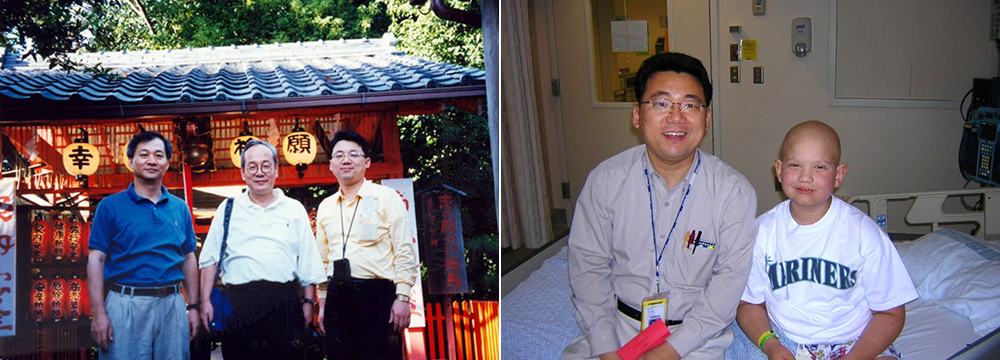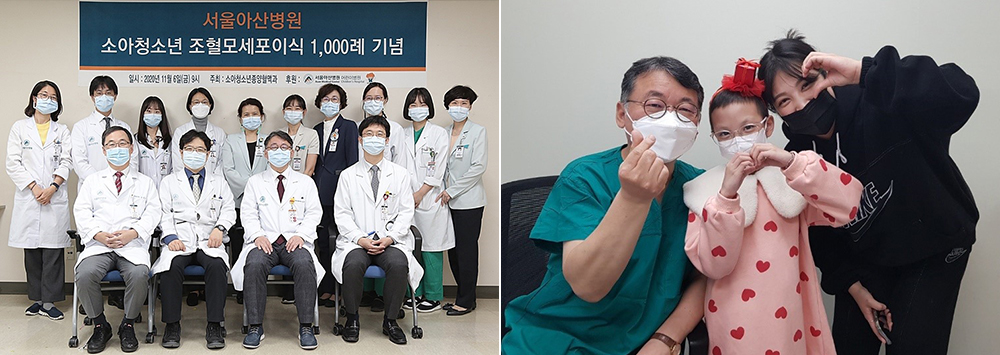-
- Global AMC MENU
- NEWS
- HEALTH
- PEOPLE
- Introduction
Professor Ho Joon Im, Division of Pediatric Hematology and Oncology
 ▲ [Left] Professor Ho Joon Im with Professor Jong Jin Seo (left) who led him to AMC and Professor Hang Lee (middle) who guided him to the field of pediatric hematology-oncology at a Japanese academic forum in 1998
▲ [Left] Professor Ho Joon Im with Professor Jong Jin Seo (left) who led him to AMC and Professor Hang Lee (middle) who guided him to the field of pediatric hematology-oncology at a Japanese academic forum in 1998
▲ [Right] Professor Ho Joon Im with a pediatric patient who has completely recovered in 2003
Professor Ho Joon Im came to Asan Medical Center in 2004, a turning point in his life. He had just returned from the U.S. with hands-on hematopoietic stem cell transplantation (HSCT) experience after having realized the limitations of pediatric patient treatment. He teamed up with his colleagues and challenged himself to perform haploidentical hematopoietic stem cell transplantation. Professor Im shares his story of giving hope to patients and their families with intractable blood diseases and childhood cancer through constant attempts and research efforts.
When did your interest in hematopoietic stem cell transplantation begin?
I learned from Professor Hang Lee who had started childhood cancer treatment in South Korea when I was working as a fellow at Hanyang University Seoul Hospital in 1995. He showed me everything I pursued, even down to how to treat patients. After treating childhood cancer patients for nearly 10 years, I felt I had hit the wall. That is why in 2013, at the pretty late age of 40 (laughs), I planned to go to the United States. At the Children’s Hospital of Fred Hutchinson Cancer Center, which was considered one of the best hospitals in hematopoietic stem cell transplantation, I was directly involved with hematopoietic stem cell transplantation treatment. I wanted to learn the latest medical techniques from actual scenes and apply them directly in South Korea, rather than studying them through journals or academic conferences. The language was a great burden to me in dealing with patients. I had never been to the U.S. before. Nonetheless, I picked up my courage because hematopoietic stem cell transplantation was a new area. After spending 1 year in the U.S., I came back to South Korea and was offered a position by Jong Jin Seo at Asan Medical Center who was then the Chair of Pediatric Hematology and Oncology. I accepted the offer and was able to fully apply what I had learned.
You attempted haploidentical hematopoietic stem cell transplantation since joining AMC in 2004
Stem cell donation for allogeneic hematopoietic stem cell transplantations at the time was made by fully histocompatible siblings or non-related individuals. Cord blood would be used in case no donor could be identified, but the results were not satisfactory. In particular, if no donor is found for patients with aplastic anemia, nothing could be done because hematopoietic stem cell transplantation is the only treatment option. So, I hung on to haploidentical hematopoietic stem cell transplantation. If any half-histocompatible parent can be a donor, the patient will at least have a chance to undergo transplantation. However, being an extremely difficult technique, many attempts have been made in South Korea only to be repeatedly unsuccessful. I also had to go through a difficult time that I do not want to remember.
Please tell us about the challenges and failures experienced at the time
We started by buying a centrifuge and a plasma separator for cell separation, all secondhand for 3 million Korean won and 500 thousand Korean won, respectively. We made attempts many a time, and just when we thought we made some progress, something else came up and we had to figure it out again.
In the beginning, it usually took 7 hours for cell separation. Nurse Specialist Eun Seok Choi worked day and night because transplantation could not be done if there were few separated cells. We would get kits in the middle of the night and keep going. When the results came out early in the morning, Professor Chan-Jeoung Park and Professor Seongsoo Jang of the Department of Laboratory Medicine would check them. Professor Seung Do Ahn of the Department of Radiation Oncology even made himself available on holidays to perform whole-body irradiation. I was lucky to have met these colleagues who had a deep affection for patients. All of them showed their skill and responsibility and refused to give in. Still, it felt like there was a hole in my heart when engraftment failed after transplantation. I just feel grateful to patients and their guardians who readily agreed to my careful suggestion of re-transplantation. Good results were accumulated with fewer failures through their support and encouragement.
 ▲ [Left] Professor Ho Joon Im (front row, second from the right) with medical staff celebrating the 1,000 cases of hematopoietic stem cell transplantation in 2020
▲ [Left] Professor Ho Joon Im (front row, second from the right) with medical staff celebrating the 1,000 cases of hematopoietic stem cell transplantation in 2020
▲ [Right] Professor Ho Joon Im with So-dam who underwent hematopoietic stem cell transplantation last year
It must have taken a lot of courage because the attempts were challenging
I remember our first attempt. 9-year-old Yong-jin had low white blood cell count. It was quite clear that he would soon pass away due to the recurrence of pneumonia. I persuaded his guardians, and they agreed to go for transplantation. However, due to my own fear, there was a part of me hoping the guardians would give up. I wanted to run away. After the successful treatment, I realized that happiness comes after overcoming fear.
Later, we studied more about the treatment that requires hundreds of millions of Korean won in the event of complications and completely changed the approach in 2007. Following the success of transplantation in 12 aplastic anemia patients, our experience has been reported to academic communities across the world and cited in numerous papers. With efforts made by a lot of medical staff and support from Asan Medical Center, the number of hematopoietic stem cell transplantation cases increased to 1,000 in 2020 which was only 100 in 2004.
What do pediatric patients mean to you?
Nowadays, I laugh every time I visit 7-year-old So-dam’s ward. One day, So-dam said, “Professor, the ‘some’-thing on your shoulder seems to exhaust you,” and I wondered, ‘Do I seem worn out?’ Then, So-dam immediately gave me a finger heart saying, “Hand-‘some’” I returned a finger heart. Looking at So-dam who became healthy after hematopoietic stem cell transplantation, I feel infinite happiness. Children come to me and receive a chance to be cured, and in return, I gain happiness from them. I believe this has led me to spend 28 years full of challenges and gratefulness with children who have intractable blood diseases and childhood cancer.












